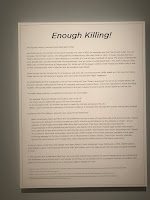1. What were you expectations for this course and where they met?
I hoped to learn from other and how they view the art world. I believe this expectation was met. It was nice to read and see what other students chose to talk about in their blogs and discussions.
2. Now that you've been through this course, What is art? How would you define it now compared to your initial posting?
Art is showing meaning through creativity. I believe that we all are capable of creating art and there are several art forms. Art isn’t just something that’s always beautiful but its something powerful and how meaning in it and was created for a reason.
3. Who was your favorite artist in your original posting and who is your favorite visual artist now? If there is a difference, why do you think so? If you have the same favorite artist, why do you think so?
I did not choose a favorite artist in my first post. There are too many artists out there for me to choose a favorite. I did discover a lot of artist while doing assignments for this class and one I really enjoyed was Lorraine Loots. The fact she was able to create one artwork a day for a year is quite remarkable. She has become one of my favorites because of her passion and precision in her artwork. I aspire to do an artwork a day for a year, someday.
4. Now that you've completed this course, how do you feel about taking an online course? Is your answer the same as it was in your first posting? How is it the same or different?
I was surprised by how easy it was to navigate through the online course. In the beginning I was afraid things would get lost, but I think as long as you are organized and stay on top of your assignments, then taking an online class is pretty straight forward. I did miss the face to face interaction but I also enjoyed that I could do the assignments at my leisure. It was nice to be able to do things when I had the time, instead of going to a scheduled class.










